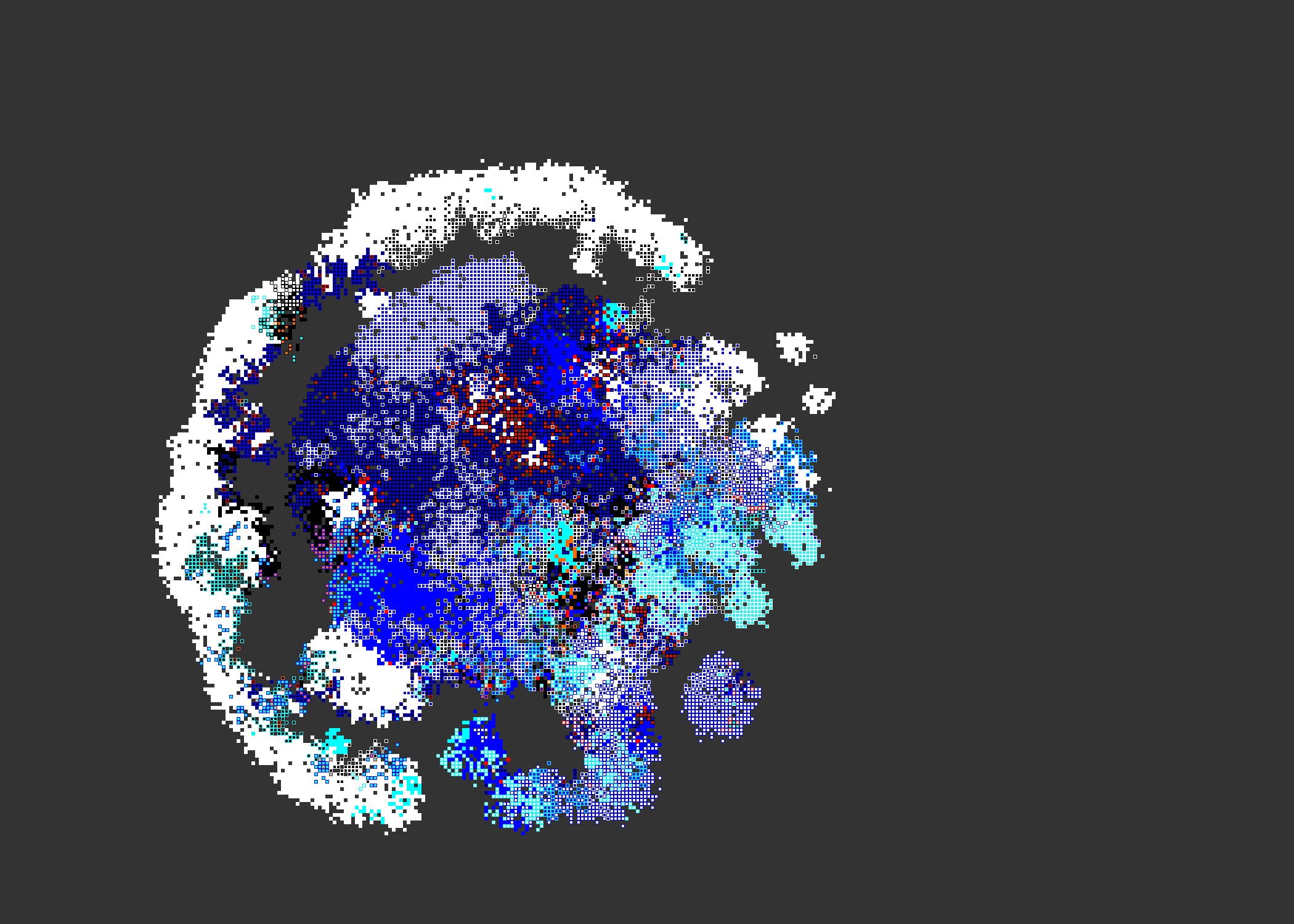
Much work has been done in so-called "artificial life" to simulate various evolutionary systems. While some work has been done to simulate cultural evolution, almost no work has been done to simulate the evolution of culture's foundation: communication.
Any simulation of culture that doesn't evolve the ability to communicate from an artificial genetic basis is bound to fail to address the most important question:
How is the genetic capacity for communication maintained in the presence of the evolutionary incentive to manipulate signals rather than communicate?
My preliminary research based on the demographic memetic prisoner dilemma (with climate variation) indicates it is very difficult to sustain communication if high migration rates are allowed.
| The image at this link is a
snapshot of a computer simulated ecosystem in which individuals can
communicate, defect and/or cooperate under the prisoner's dilemma. The
snapshot was taken after 1413 generations of evolution.
In the Prisoner's Dilemma if two individuals cooperate they each win 3 points for a total of 6. If one cooperates and the other defects then the cooperator wins 0 points and the defector wins 5 points for a total of 5. If they both defect they each get 1 point for a total of 2. Clearly, a world in which everyone is cooperating is going to have more total "points" than one in which there are defectors. The question haunting biologists is how can cooperation evolve under these conditions? It is made even more complex when one questions how communication can evolve under these conditions since if one can simply say "cooperate" to another player, they allow your signal to influence their behavior accordlingly and then you defect against them, their lineage will die while yours prospers. This simulation is a world that attempts to model what many others have implicitly attempted to analyze -- the most recent fad being Simpson's Paradox that is used by David Sloan-Wilson to discuss the merits of large groups such as religions without ever dealing with impact of modern technology on ecology let alone human ecology. All of these are valiant attempts to achieve what the man who many consider the founder of neo-Darwinian theory, W. D. Hamilton, best characterized in his 1975 paper "Innate Social Aptitudes of Man". He concluded that classic paper with this statement about the Prisoner's Dilemma in the evolution of human social aptitudes: there is a law, and we can see why, and that sadly we also see the protean nature of this Dilemma, which, when suppressed at one level, gathers its strength at another. Basically he is saying the Prisoner's Dilemma cannot be avoided in evolution for if it is averted at one level of evolution is reappears at another: Say from the gene to the individual organism or to the group. At the start of the simulation all locations in the 2d universe have a manipulable gossip who is cooperating with its nearest neighbors and telling them to cooperate. The next generation those players will then continue to say what they heard, which is "cooperate" and will do what they heard, which is "cooperate". On rare occasion a mutation occurs. This mutation can be in either the nature of the player or in the nature of its memory. This is a way of allowing the universe to evolve into a state other than pure manipulable gossips. The center of the circular structure is the place with the most benign environment. The further from the center of the circle one gets the more harsh the environment until it becomes uninhabitable (grey). This is achieved by subtracting a cost-of-living from each player's vitality each turn and making it proportional to the distance from the center. Vitality is required to reproduce and as a player ages it loses vitality at an ever increasing rate. When it goes to 0 it dies. The pure white partial circle you see around the structure is a ring of
pure cooperators -- they walk their talk which is 'cooperate'. You will
notice on the inside edge of the white ring are cells with black interiors
and white exteriors. These are hypocrites that say 'cooperate' and yet
always defect. The regions where hypocrites are eating into pure
cooperators will become grey if the climate is too harsh (too far from the
center). Therefore, just inside the place where we see hypocrites eating
outward toward the cooperators there is a ring of death -- a grey gulf
between them and the rest of the ecosystem.
'seen' == last experienced 'heard' == last heard For example, a cell with white boundary and black interior would be a demonic preacher (hardcore hypocrite). A cell with orange boundary and blue interior would be a gossiping skeptic who had last heard 'defect' and last experienced altruism. Direct actions based on what is said is indicated by an interior color of either orange or cyan. Such cells are required for communication to exist. Note they are almost entirely located at the boundary of the dead zone where hypocrites (black interior, non-black exterior) of various stripes thrive. The interaction and migration radius are both Gaussian. The radius is about 1 cell. (There are those who say this world is too pessimistic -- that keeping accounts as to which individuals did what prevents "pay it forward" behavior --behavior that can end up feeding demons and eating altruists. It is difficult not to sound like a satirist when one has to point out the reality of high-level accounting firms within this context. |
